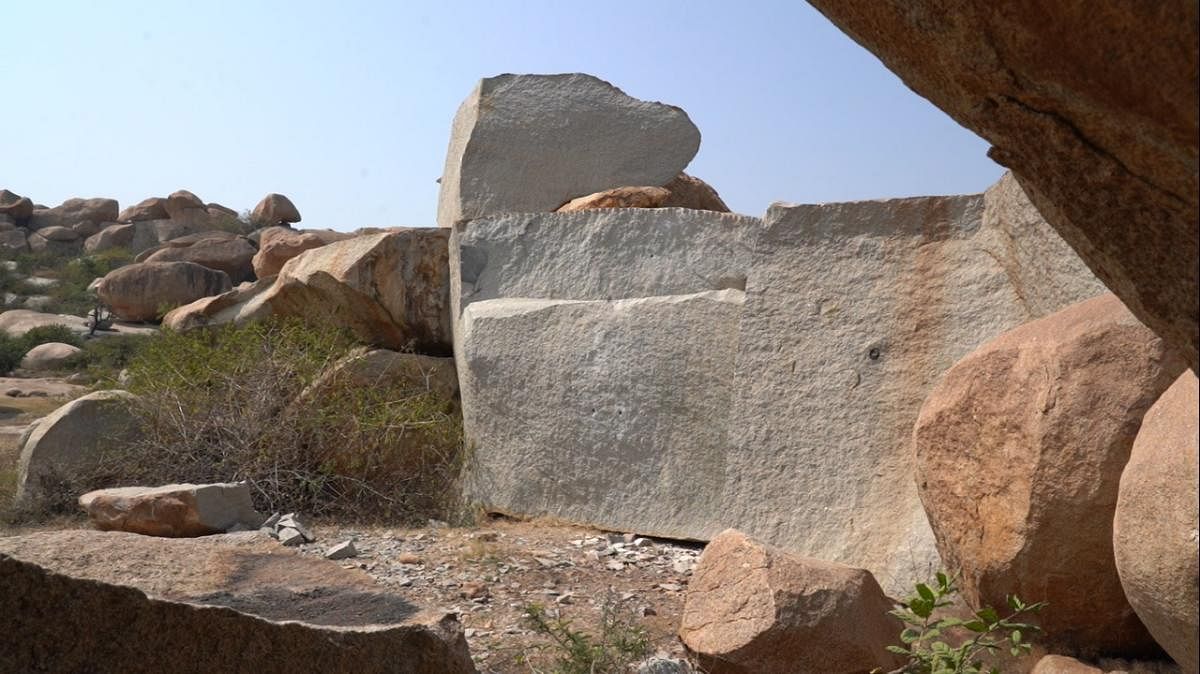
Unabated illegal stone quarrying and rampant iron ore mining are threatening the very existence of the Neolithic Age cave/shelter paintings and protected monuments within the jurisdiction of the Hampi World Heritage Area Management Authority (HWHAMA).
Karadivatalu, part of the seven hillock series in Gangavathi taluk, is crying for attention of the administration as illegal stone quarrying has already destroyed tens of cave and shelter paintings, which, according to experts, date back to more than 4,000 years.
Sadly, the district administration, the Archaeological Survey of India (ASI) and the Karnataka Department of Archaeology Museums And Heritage (DAMH) have not made much effort to protect these national treasures, while ASI’s Dharwad officials said such historical sites are not listed in the centrally protected monuments, DAMH, Hampi.
Field Director Prahlad, who visited the affected sites after being alerted by DH, said these sites are not covered under the protected monuments list of DAMH. He, however, said he would soon send a report to his superiors, recommending that these paintings be safeguarded from illegal quarrying.
Sharanabasappa Kolkar, principal of KSC Women’s College, Gangavathi, who has done his doctoral thesis on these cave paintings, said he had identified more than 120 cave/shelter paintings in these hills during his research work in 1998-2000.
However, during a similar research by a student of Pune’s Deccan College in 2020, the majority of those boulders on which the paintings were drawn were found missing.
Recently, illegal stone quarry operators blasted a boulder that was just 20 metres away from one such shelter painting in Karadivatalu, which is just 25 km from Hampi. According to Kolkar, similar sites in Ramapur, Mallapur and other parts of Gangavathi taluk have already been lost due to stone quarrying.
“If a proper exploration is conducted in these seven hills, we can definitely find more than 250 paintings,” he said.
Senior archaeologist Ravi Korisettar said many hills in and around Hampi, Hosapete, Gangavathi, Ballari and Koppal have sites that are connected to the Neolithic Age.
However, not much study has been done on them. Several such sites, including the ash mounds in Sanganakallu, eight km from Ballari, have been lost due to rampant
mining and stone quarrying.
“Even the Mines & Geology Department officials give permission for excavation of minerals and stones without conducting a proper study of the area. An archaeological study should be made here before permitting mining,” said Korisettar.
Koppal Deputy Commissioner Suralkar Vikas Kishor, who is also the co-chairman of HWHAMA, said, there is a need for a greater exploration of the Gangavathi region to identify such cave paintings and protect them.
“The district administration is looking for legal options to prevent illegal stone quarrying in the region.”
Wrongly blamed
The blasting of huge boulders in Anjanadri hills, Koppal district, has also resulted in the collapse of the fort wall, which is said to belong to the Vijayanagara era.
Krishnamurthy, who belongs to the Bhovi community that is involved in stone cutting using hand tools, blamed the involvement of influential people and their followers for the damage to the fort and other protected monuments in the area.
Sandur mining
Sri Kumaraswamy Temple, an eighth-century Chalukya era temple in Sandur’s Swamimalai Forest Division, is fighting a survival battle for the last three years after the state government reduced the no-mining area from 2 km to 300 mt radius around an ASI protected monument.
Two C-Category iron ore mines are within a distance of 1 km from this protected monument, and vibrations are felt even in the sanctum of this temple when blasting takes place in mines that are as far away as 3 km.
Activist Sreeshaila Aladahalli said Naviluthirtha, Harishankar temple and many other protected temples are under threat from mining in Sandur.